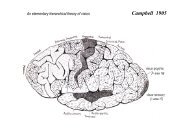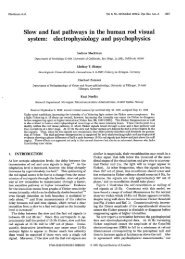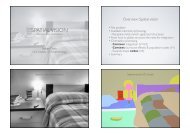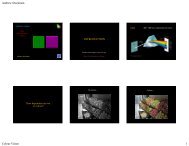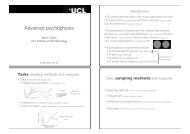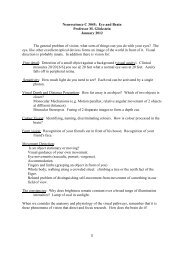<strong>Journal</strong> <strong>of</strong> <strong>Vision</strong> (2005) 5, 702–716 Stockman & Plummer 705MLSubject Level Slow/fast (m) Dt Slow sign Slow/fast (m) Dt Slow signAS 1 1.79 39.82 Minus 0.03 25.22 Plus2 2.44 31.48 Minus 0.32 31.63 Plus3 2.87 22.72 Minus 0.49 21.60 Plus4 1.31 29.50 Plus 0.40 25.08 MinusDP 1 1.67 32.70 Minus 0.04 29.94 Plus2 3.15 30.74 Minus 0.33 28.81 Plus3 4.51 21.71 Minus 0.41 20.57 Plus4 27.96 33.56 Plus 0.63 27.79 MinusTable 1. Parameters <strong>of</strong> time delay model fitted to M- and L-cone phase data shown in Figure 1. The parameters are the ratio <strong>of</strong> <strong>slow</strong>/fastsignal size, the time delay (Dt) in ms between the <strong>slow</strong> and fast signals, and the sign <strong>of</strong> the <strong>slow</strong> signal with respect to that <strong>of</strong> the fast. Fordetails see text.Bsignatures[ that should be found in any experimentaldata that reflect the simple combination <strong>of</strong> <strong>slow</strong> and fastsignals. A comparison between the phase signatures andthe phase data <strong>of</strong> Figure 1 shows that the two are indeedsimilar, which suggests the phase data are broadly consistentwith our model. The continuous lines in Figure 1are fits <strong>of</strong> this model to the M- and L-cone phase data. AtLevels 1Y3 (8.93Y11.18 log 10 quanta s 1 deg 2 ), the dominant<strong>slow</strong> and fast signals are +sL, sM, +fL, and +fM, asillustrated in the lower right circuit diagram <strong>of</strong> Figure 1,whereas at Level 4 (12.50 log 10 quanta s 1 deg 2 ) theyare sL, +sM, +fL, and +fM, as illustrated in the upperright circuit diagram. Table 1 summarizes the best-fittingmodel parameters for the fits to the M- and L-cone datashown in Figure 1. The <strong>slow</strong>/fast signal ratios (m) aretypically small for L-cone signals and large for M-conesignals, whereas Dt varies between 20 and 40 ms. (Thevalues for Level 1 are anomalous, because the equichromatictarget is below M-cone threshold and is thereforean L-cone stimulus.)The crucial change in the model parameters thatoccurs between Levels 3 and 4 (11.18 and 12.50 logquanta s 1 deg 2 ) is that the polarities <strong>of</strong> the both the<strong>slow</strong> M-cone and the <strong>slow</strong> L-cone signals reverse. Thus,the <strong>slow</strong>, spectrally opponent signals change from+sL sM to sL+sM. In this paper, we focus on thechanges in phase delay and flicker spectral sensitivity thatoccur between Levels 3 and 4.MethodsApparatusThe optical apparatus was a conventional five-channel,Maxwellian-view optical system with a 2-mm entrancepupil illuminated by a 900-W Xenon arc. Wavelengthswere selected by the use <strong>of</strong> interference filters with fullwidthat half-maximum bandwidths <strong>of</strong> between 7 and11 nm (Ealing or Oriel). The radiance <strong>of</strong> each beam couldbe varied by the insertion <strong>of</strong> fixed neutral density filters(Oriel) or under computer control by the rotation <strong>of</strong>circular, variable neutral density filters (Rolyn Optics).Sinusoidal modulation was produced by the pulse-widthmodulation <strong>of</strong> fast, liquid crystal light shutters (Displaytech)at a carrier frequency <strong>of</strong> 400 Hz. The position <strong>of</strong> theobserver’s head was maintained by a dental wax impression.The apparatus is described in more detail elsewhere(Stockman et al., 2005).StimuliIn all experiments, target stimuli <strong>of</strong> 4- <strong>of</strong> visual anglein diameter were superimposed in the center <strong>of</strong> a steady658-nm background field <strong>of</strong> 9- in diameter. Fixation wascentral. Calibrations were carried out with the use <strong>of</strong> aUDT Radiometer and a spectroradiometer (E,G & G). Forfurther details, see Stockman et al. (2005).BackgroundsThe 658-nm background was varied in radiance from10.39 to 12.38 log 10 quanta s 1 deg 2 . Given the relativeinsensitivity <strong>of</strong> rods and S-cones to the long-<strong>wavelength</strong>fields, it was important to ensure that the rods and S-conesdid not detect the 520-nm target. To desensitize therods and S-cones, an auxiliary 410-nm background <strong>of</strong>10.30 log 10 quanta s 1 deg 2 was superimposed on the658-nm background. Given that the S-cones are one logunit more sensitive to the auxiliary background <strong>wavelength</strong><strong>of</strong> 410 nm than they are to the shortest target<strong>wavelength</strong> <strong>of</strong> 520 nm (Stockman & Sharpe, 2000), theS-cone modulations produced by the 520-nm targets (seeFigure 5 for the radiances used) were well below S-conemodulation threshold (see Stockman, MacLeod, & DePriest,1991). As expected, therefore, in control experiments wecould find no evidence that the S-cones contributed toour measurements.
<strong>Journal</strong> <strong>of</strong> <strong>Vision</strong> (2005) 5, 702–716 Stockman & Plummer 706We used single or combined 520 and 650 nm monochromatictargets. Flicker frequencies <strong>of</strong> 2.5, 7.5, 15, and22.5 Hz were used. Monochromatic targets were usedrather than cone-isolating targets, because <strong>of</strong> the large andabrupt changes in phase delay and spectral sensitivity thatoccur between Levels 3 and 4. M- and L-cone-isolatingtargets require the use <strong>of</strong> paired, alternating stimuli thatare equated for (and therefore invisible to) the unwantedcone type. We were concerned that paired targets that wereslightly imperfectly equated could generate small signalsfrom the unwanted cone type. Although usually well belowthreshold, such signals could become visually significantif the resultant signals from the wanted cone type arecancelled by destructive interference, which is likelyunder some <strong>of</strong> the conditions <strong>of</strong> our experiment. Usingmonochromatic lights avoids this problem but means thatthe phase lags are harder to interpret because mostspectral targets typically produce both M- and L-conesignals even on the 658-nm background (see below).The 520-nm targetAlthough the flickering 520-nm target generates predominantlyan M-cone signal on the long-<strong>wavelength</strong> background,it also generates a small L-cone signal (a shorter <strong>wavelength</strong>target would have reduced the L-cone contributionbut would have had the unwanted effect <strong>of</strong> increasing thelikelihood <strong>of</strong> an S-cone contribution). This small L-conesignal is evidenced by the <strong>slow</strong>/fast signal ratios (m)values for 500 and 540 nm flickering targets being lessthan the m values for pure M-cone targets (Stockman &Plummer, 2005; Stockman et al., 2005). The <strong>slow</strong> component<strong>of</strong> the L-cone signal produced by the 520-nm targetis much smaller than the fast L-cone component (seeTable 1) and is cancelled by the stronger opposite polarity<strong>slow</strong> M-cone signals. Consequently, the L-conesignal produced by the 520-nm target can be thought<strong>of</strong> as mainly a fast +fL signal, which adds to the fastM-cone signal (+fM).For the interpretation <strong>of</strong> our data, therefore, we assumethat the 520-nm flickering light generates sM, +fM, and+fL flicker signals at lower 658 nm intensity levels and+sM, +fM, and +fL flicker signals at higher levels.The 650-nm targetOn the long-<strong>wavelength</strong> 658-nm background, theflickering 650-nm target generates both M- and L-coneflicker signals (once, that is, the target is intense enoughto exceed M-cone flicker threshold, which is not the caseat Level 1). Because the 650-nm target is approximatelyequichromatic with the 658-nm background, it producesmainly luminance modulation with comparatively littlechromatic modulation. We assume, therefore, that it generatespredominantly fast signals (+fL and +fM). Thisassumption implies that the two opposing <strong>slow</strong> signals areroughly balanced under these conditions (i.e., sM +sLand +sM sL) and cancel; an assumption for whichthere is good evidence under a variety <strong>of</strong> conditions forconventional chromatic channels (Chaparro, Stromeyer,Chen, & Kronauer, 1995; Eskew, McLellan, & Giulianini,1999; Stromeyer, Cole, & Kronauer, 1985). If, contrary tothis assumption, the spectrally opponent signals are slightlyunbalanced, and the equichromatic flickering target doesgenerate a small <strong>slow</strong> signal, then the relative strengths<strong>of</strong> the <strong>slow</strong> signal will be underestimated for the 650-nmtarget and overestimated for the 520-nm target. For theinterpretation <strong>of</strong> our data, we assume that the 650-nmflickering light generates +fM and +fL flicker signals.The flickering targets were continuously presented, sothat in the central 4- observers were adapted to the meanradiance <strong>of</strong> the flickering targets plus the steady background.The amplitude threshold radiances <strong>of</strong> the flickeringtargets are plotted in Figure 5 (their mean radiancesare 0.3 log unit less than the plotted values). Under mostconditions, the target radiances are small relative to thebackground radiance, so that the targets shift the effectiveadapting <strong>wavelength</strong> from the field <strong>wavelength</strong> <strong>of</strong> 658 nmto <strong>wavelength</strong>s only 4-nm shorter or usually less. Theonly conditions under which the 520-nm target is brightenough to cause sizeable <strong>wavelength</strong> shifts are at 15 and22.5 Hz for DP at the very highest background radiances,where the loss <strong>of</strong> sensitivity to 520-nm flicker significantlyexceeds Weber’s Law (see Figure 5). The worst case isat 22.5 Hz at the highest background radiance, wherethe effective <strong>wavelength</strong> is shifted by 12nm to 646 nm.This slightly shifts the Weber predictions (see below) butdoes not affect the conclusions. The effective adapting<strong>wavelength</strong> was calculated by finding the <strong>wavelength</strong>that gives rise the same relative L- and M-cone excitationas the combined background and targets according to theStockman and Sharpe (2000) cone fundamentals.ProceduresSubjects light adapted to the target and background fieldsfor at least 3 min prior to any data collection. During theexperiment, each subject interacted with the computer bymeans <strong>of</strong> eight buttons on a keypad. The computer providedinstructions and gave verbal and other auditory feedbackby way <strong>of</strong> a voice synthesizer and tones.Flicker thresholds were found by the method <strong>of</strong> adjustment.The modulation <strong>of</strong> the flickering stimulus was set tothe maximum level <strong>of</strong> 92% and its amplitude was varied t<strong>of</strong>ind the threshold for detecting the flicker. Phase differenceswere measured between the superimposed 520 and650 nm flickering lights using a flicker cancellation technique.First, each subject adjusted the modulation <strong>of</strong> thetwo lights separately (with the other light set at zero modulation)until the flicker was just above threshold (typicallyc. 0.2 log 10 above threshold). Then, the subject adjustedthe phase difference between the two lights and if nec-




